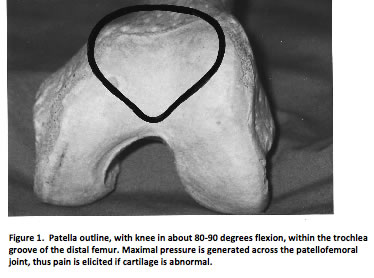
|
| HOME ABOUT PRODUCTS ORDER TESTIMONIALS ARTICLES CONTACT |
The SEIZA Position-Why It Relieves Knee PainUsually anterior knee pain, especially kneecap pain, is made much worse by hyperflexion of the knee, under load. In other words, if your kneecap is tender or painful, bending it while supporting a weight, as when climbing stairs, is likely to make it much worse. Oddly enough, though, the seiza position relieves that pain, even though the knee is maximally bent. Once you get used to it, the position is actually comfortable. And that doesn't seem to make sense. The answer to this apparent paradox, however, lies in the relevant anatomy of the patellofemoral joint. If you look at the lower end of a human thigh bone, or femur, you will see that the weight bearing area, the articular surface, is divided into inner and outer condyles (curved, bean-shaped segments) by an arch-shaped "open area," called the intercondylar notch (see Figure 1). This area is where the cruciate ligaments are attached. Now, just superior to this notch is an angled groove in the front of the lower femur, in which the kneecap rides, when the knee is bent, like a train on its tracks. This groove or valley between the condyles is called the trochlea. Like the back surface of the patella (kneecap), it's coated with a layer of articular cartilage.   When the knee is bent, the kneecap rides along within the trochlea and compression forces the cartilage of the kneecap down against the cartilage of the trochlea. The more weight or resistance that's applied to the knee, the more pressure compresses the kneecap into the groove. When the cartilage is diseased, softened or fragmented (chondromalacia patellae, or arthritis), its protective function is compromised. In this case, the pressure gets through the cartilage into the bone, where it stimulates the nerves in the bone and is perceived as pain. When the knee is in seiza position, however, it flexes even beyond that point, so the kneecap literally "runs out of track," leaves the confines of the trochlea groove and is pulled beyond the bone, down into the bare area of the intercondylar notch, where there is no firm opposing surface (Figure 2). Therefore, in this position, the patella resides in an interval which is free of compression and as a result is pain-free, despite the extreme flexion of the knee. |